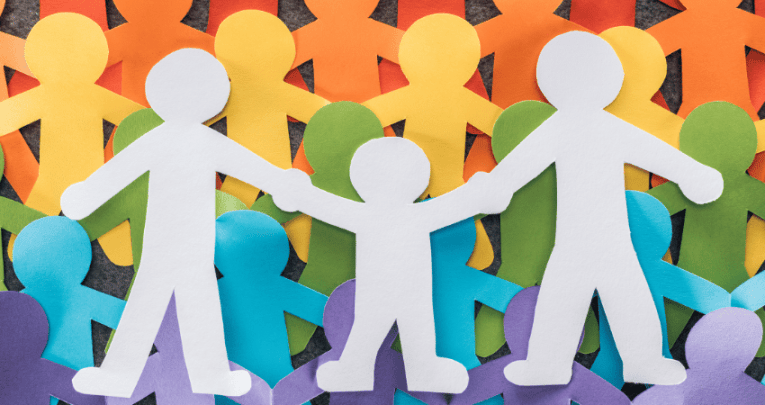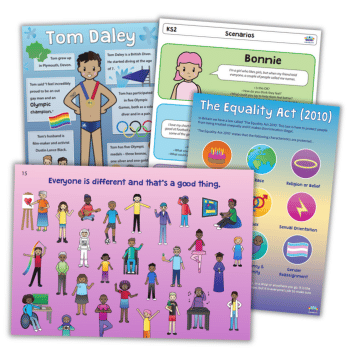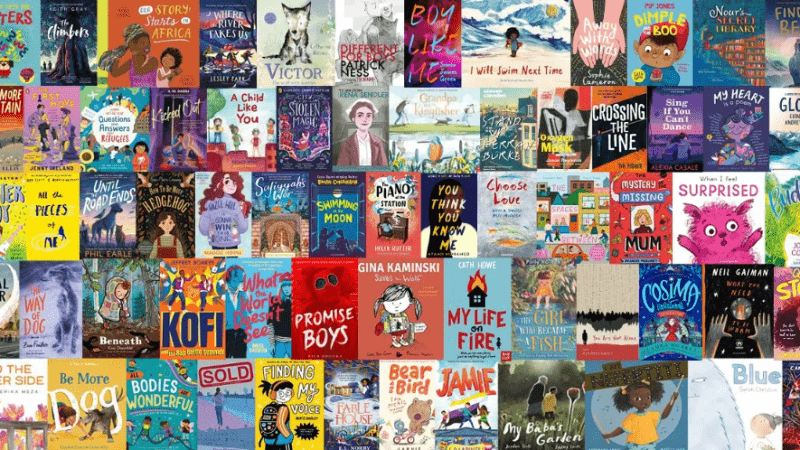Inclusive education – Making school a happy place for LGBT+ kids

Practical, time-efficient ideas for fostering LGBT+ inclusion in your classroom and creating a happier environment for all students…

- by Teachwire
- Classroom expertise and free resources for teachers

LGBT+ inclusion doesn’t have to take a lot of time. In fact, it can fit seamlessly into your classroom, making it a happier place for everyone. Here are some ideas for providing an inclusive education for all of your students…
How to combat prejudice
I run LGBT+ inclusive assemblies and workshops in schools. For the past seven years, I’ve worked with thousands of primary-age children.
The difference I’ve observed in pupils is transformational. Year 2s are much more accepting of, for example, boys who like wearing dresses or girls who love playing football.
Year 3s tell me that it doesn’t matter if you don’t know someone’s gender – you can still be friends. And Year 6s are articulate and thoughtful when they suggest ideas for how to ensure a trans child would feel welcome in their school.
As teachers, taking on anything that adds to our workload can seem too much. So I’m delighted to tell you that taking a little bit of time to talk about LGBT+ lives is much easier than you might think. It will definitely pay back way more than the time you’ve invested.
Just drop it in
When I first asked my Year 6 class to tell me where the apostrophe goes in ‘Simons boyfriend’, I was really nervous that someone would laugh or say something offensive, but no one made any comment. They just got on and told me where to put the apostrophe.
I was amazed that the children didn’t bat an eye at this kind of inclusive language – and that it was me that was needlessly worrying about it.
After all, many children have LGBT+ friends and family members and the number of young people coming out is increasing all the time (The Guardian, 2023).
When we drop in references to LGBT+ lives, we’re just making sure everyone is represented. Maths is super easy for drop-ins, too. For example: Sam and his two dads went to the cinema. How much did it cost if…?
Unnecessary gendering
For very good reason, we never ask children to line up separately by their skin colour. So why do so many of us still split them up depending on their gender?
A Year 5 child recently told me how horrible this made them feel (and this isn’t the only child to have told me this). “The teachers don’t know I’m non-binary”, they said, “so when they split us up boy/girl it makes me feel…”, and then they rubbed their tummy as if in pain.
Instead, try dividing children by asking, for example, “Would you rather be a unicorn or a dragon or neither?”, or “Do you prefer chocolate or ice cream or neither?”
Visibility
LGBT+ people have flown in space, dived in the Olympics, invented an early version of the computer, and much more.
When we are talking about someone’s achievements, and they happen to be LGBT+, we can drop that fact in as part of the teaching, letting children know that being LGBT+ is just another way to be a human.
For example, if you’re teaching your class about space exploration, mention that astronaut Sally Ride was a lesbian and had a lifelong partner who helped her teach kids about science.
We don’t need to avoid words like ‘gay’, ‘lesbian’ or ‘non-binary’. We can explain them in simple, age-appropriate language, such as saying that ‘gay means a man who loves a man’, etc.
For those of us who grew up without this kind of inclusive language at school, it can feel a bit forced at first, but it soon becomes second nature.
Toilets and uniform
Children are great at problem-solving. In my Year 6 session, I read a children’s book about a trans child going to school and then asked the children if they think they would welcome a trans child in their school.
They always say an enthusiastic, ‘Yes, of course’. The children’s ideas for making things more inclusive include making at least some toilets available for any gender and making sure that all school uniform can be worn by anyone.
For the children, it’s simple. What’s more, it’s so easy to do that the majority of schools I work with have now made ideas like this a reality.
Parents
I’ve worked with thousands of school children and virtually all the parents have been supportive of LGBT+ inclusive work. We know that 82 per cent of parents support teaching children about same-sex parents (Just Like Us, 2022).
Sadly, some people have been frightened by misinformation. Giving families the opportunity to be a genuine part of the conversation and be involved in how your school develops its inclusivity policies can help them feel more confident, and, most importantly, to feel heard and respected
When talking to parents, it’s a great idea to group teaching about different protected characteristics together. Being LGBT+ is just another way to be a human, and equal and fair treatment in schools is governed by The Equality Act 2010.
Giving families an opportunity to review resources that teach about different races, religions, disabilities and LGBT+ identities helps to frame this particular strand of inclusivity as part of a celebration of diversity designed to ensure that all children and families feel respected, welcome and included in your school.
This almost certainly ties in very well with your school’s existing ethos and values, whichever words you use to express that with the children.
Resources
If you’re developing or updating your school’s inclusion policy, you might want to take a look at the RSHE guidance, as well as Pop’n’Olly’s free ‘Discussions with parents’ resource that brings together current information on legal frameworks.
Prejudice is a learned behaviour, but preventing it from developing is much easier than you might think. Just a few simple actions regularly repeated can be transformative for children, staff and families in your school.
Trending
Mel Lane (she/her) is a former primary school teacher and teacher trainer, and is now head of education at education resource provider Pop’n’Olly.
Why LGBTQ+ resources for primary schools are vital
My teachers weren’t allowed to talk about same-sex relationships and I didn’t even realise I was gay. Inclusive representation changes everything, says Amie Taylor…
“No, no, no. That’s a prince!,” an eight-year-old boy in the front row cheerfully heckled as we reached the wedding part of our LGBTQ+ friendly show for kids in a London primary school.
We were at a crucial point – the two princesses were about to get married. I paused the show. “It’s a princess. They’re both princesses.” He chuckled and said, “No, it’s a prince!”.
“It’s definitely a princess,” I assured him. “How do you know?” he asked. “I made the play,” I replied. This answer seemed to satisfy him. He shrugged and allowed us to continue.
Later, back in the classroom, we were making shadow puppets as a follow-up activity to the performance. As always I took the opportunity to circulate and chat to the kids about the show.
“What was your favourite part?” The same boy piped up again, saying, “The romance.” I had to hide an almighty grin. Half an hour ago there was a question as to whether two princesses could even get married.
Accepting
I made the play, Once Upon a City, in 2018, with funding from the Arts Council. I’ve since toured to theatres, festivals and schools all over the UK.
Over the past couple of years I’ve seen how accepting children are of the LGBTQ+ community.
As soon as you explain that some women marry women and some men marry men, there’s never an issue. And there’s an added joy when you meet a child at the end, hopping up and down on one foot, desperate to tell you that they have two mums or two dads.
Some people argue that EYFS or KS1 is too young to start this work, but I wholeheartedly disagree.
Children are presented with a range of narratives, stories and movies featuring heterosexual relationships from a very young age, so it’s vital for them to see same-sex relationships too, otherwise we are telling them that these relationships are different, ‘other’ and in some way shameful.
Section 28
A major catalyst for me to make this work was growing up without any LGBTQ+ representation or role models. Knowing the impact that had on my life, I wanted to bring representation to at least a handful of children in the next generation and make their journey a little easier than mine.
Growing up under Thatcher’s Section 28, which stated that local authorities and maintained schools couldn’t promote the teaching of the acceptability of homosexuality, meant that none of my teachers were legally allowed to talk about LGBTQ+ people or same-sex relationships.
There was very little representation on TV or in books. What little I did see about gay people was often negative or stereotyped. The result of this was that I didn’t realise I was gay until I was in my mid-twenties.
I didn’t hide my sexuality; growing up without representation meant I simply hadn’t realised I was gay.
Extra support
The introduction of compulsory inclusive sex and relationship education was a huge cause for celebration. I know first-hand the difference this makes to children who grow up to be LGBTQ+, and those that have same-sex parents, a trans family member or a gay aunt or uncle.
I consolidated my theatre work for children by writing a book for teachers who may not be LGBTQ+ and need a little extra support.
It contains stories, worksheets and drama activities to make delivering inclusive relationships and sex education both easy and really, really fun. I genuinely believe that inclusive representation changes everything; it shows all children their potential and not just a small cross-section.
Having strong and successful role models allows pupils to find their true identity sooner and to feel proud of who they are.
I believe the earlier they see those role models, the better. It also builds acceptance and allyship from non-LGBTQ+ friends.
When I ask children at the end of a show what they’ve learnt, frequently the answer is that ‘two women can get married.’ I can’t wait for the day when we have nothing to teach children anymore, because it’s just a given.
Amie Taylor is a writer, theatre maker and author of The Big Book of LGBTQ+ Activities (Jessica Kingsley Publishers). Follow her on X at @amieamietay.
Discover resources for LGBT History Month and Pride Month.







